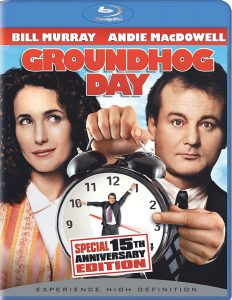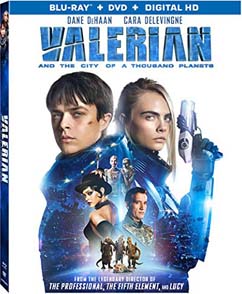I consider myself to be an amateur “Star Wars” historian, but until recently, I didn’t know about the influence of the “Valerian and Laureline” comics on George Lucas’ saga. Pulling the 1997 “Magic of Myth” book off my shelf, I don’t find “Valerian” or its creators — writer Pierre Christin and artist Jean-Claude Mézières – in the index. Maybe it’s because it was a French rather than American creation, but at any rate, it’s clear that “Star Wars” borrowed from “Valerian,” which began in 1967 and is still going today.
Thanks to writer-director Luc Besson’s spectacular “Valerian and the City of a Thousand Planets” — now available via Redbox and streaming – “Valerian” is enjoying renewed scholarship. In addition to being a strong film on its own, it serves as a thesis statement on how the title influenced “Star Wars,” the more epic “Star Trek” episodes and movies, James Cameron’s “Avatar,” Besson’s own “The Fifth Element,” and other grand adventures set in a spacefaring future. Obviously, the French comic itself came in the wake of “Flash Gordon,” but its place on the continuum is essential.
In fact, if the movie wasn’t an adaptation of its source material, it would at times play as a ripoff of “Star Wars” and “Avatar.” At one point, our heroic agents – charismatic Valerian (Dane DeHaan) and second-fiddle-to-no-one (despite being snubbed from the movie title) partner Laureline (Cara Delevingne) — escape into a trash compactor. And the plot centers on the peaceful Pearl people of the planet Mul, whose planet is destroyed when a human war comes to their neighborhood of space, as we see in the opening segment.
After an eye-popping but confusing early chase through multiple dimensions, “Valerian” settles into accessible A-to-B-to-C adventure plotting. Even better, a strong commentary on militarism emerges once the story coalesces, and in a refreshingly less heavy-handed manner than “Avatar’s” treatise on corporatism and strip-mining. While the connection between a nation’s military and a nation’s citizens is widely accepted as good and natural, “Valerian” shows how that connection is actually itself an entangled alliance.
Commander Filitt (Clive Owen) sees Mul as collateral damage. However, once the war has been won, he continues to pursue the genocide of the Pearl people by targeting those who escaped Mul. Partly, it’s to cover his tracks, but he also rationalizes it by speaking of the damage sanctions and reparations would do to the citizenry that funds his military — and he’s probably not wrong about that. It makes me wonder if humanity would be better off if populations and armies were disentangled; it’s probably impossible, but it’s a fun thought experiment, at least.
On a more basic level, we get the Valerian-Laureline romance, which is in the ballpark of Han-and-Leia except that Valerian actually proposes to his partner early in the film. She resists, and while there’s humor in the fact that his digital “playlist” is a list of women, Laureline correctly notices that Valerian doesn’t truly know what love is. Besson nicely ties their relationship into the overall conflict, when Valerian is challenged to do what’s right rather than what he’s supposed to do, and to trust rather than to merely serve.

Still photos illustrate what a visual feast “Valerian” is, but – as “War for the Planet of the Apes” also demonstrated – we’re now safely in the era where filmmakers don’t need to lasciviously show off their work. If a 20-year-old memory serves, Besson himself was somewhat guilty of this in “The Fifth Element,” although I’m due for a rewatch.
Alpha, a.k.a. the City of a Thousand Planets, is a great trade hub of 3 million residents floating in space, like the San Francisco of “Blade Runner” on steroids. After a nice backstory montage — set to David Bowie — shows us how the city kept growing through the centuries, Besson gives us a rich cross-section of its environments and its denizens. Valerian and Laureline move through the locales naturally; after all, it’s not remarkable to them that they live hundreds of years in the future.
Among the interesting folks and creatures we meet are a shapeshifter (Rihanna), who incorporates that ability into her song-and-dance performance; an incomprehensible race, which looks similar to Wat Tambor from “Attack of the Clones,” that aims to serve Laureline to their king for dinner; a trio of platypus-looking information brokers who alternately annoy and assist Laureline; and an adorable little armadillo-dinosaur mix called a Converter that can eat a pearl and poop out dozens more. The Converter could’ve been central to a heist plot (and is, in the early going) if the script didn’t have higher ambitions.
The only thing that makes me wonder about the state of special effects is when the Pearl people talk. Their mouths are slightly out of synch with the words. I suspect this might be on purpose, though: a way to give them an otherworldly effect. If memory serves, the blue aliens in Avatar also speak like this, as do the Green Martians on TV’s “Supergirl.”
Besson serves up “fishing” for flying creatures in a canyon, a cortex jellyfish that stores memories, and washbasins of pearls rather than water. There are also shoot-outs, fistfights and starfighter chases for the traditionalists. The humor flows naturally – such as Valerian’s banter with Alex, the ship’s computer – so the action is neither too grim nor too weightless.
It took 50 years for “Valerian” to become a major motion picture, but fortunately that was the precise amount of time needed for filmmaking technology to match the imaginations of Christin and Mézières. If we’re lucky, it won’t be another half-century till the next installment.
Click here for a complete index of “Valerian and Laureline” reviews.

